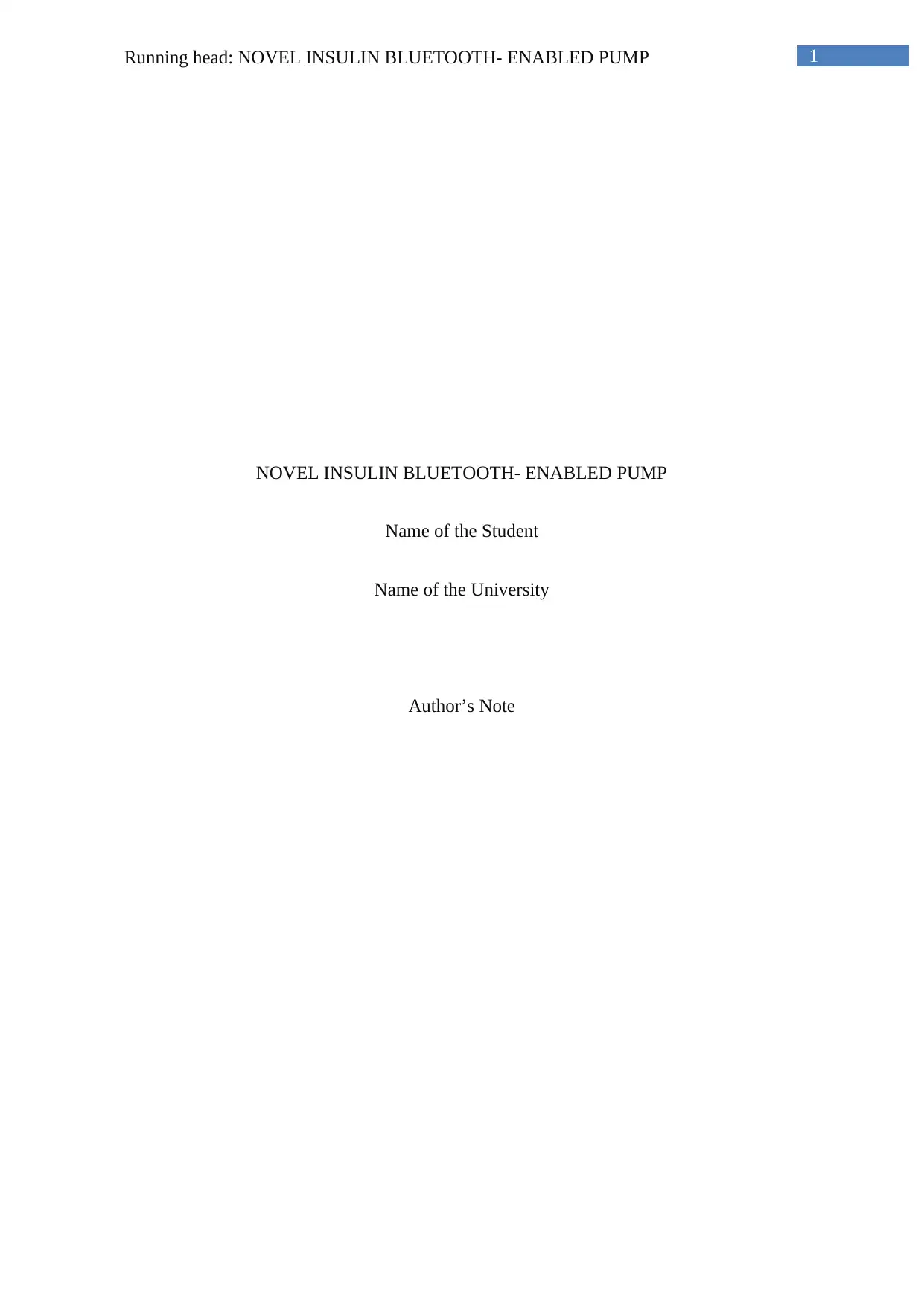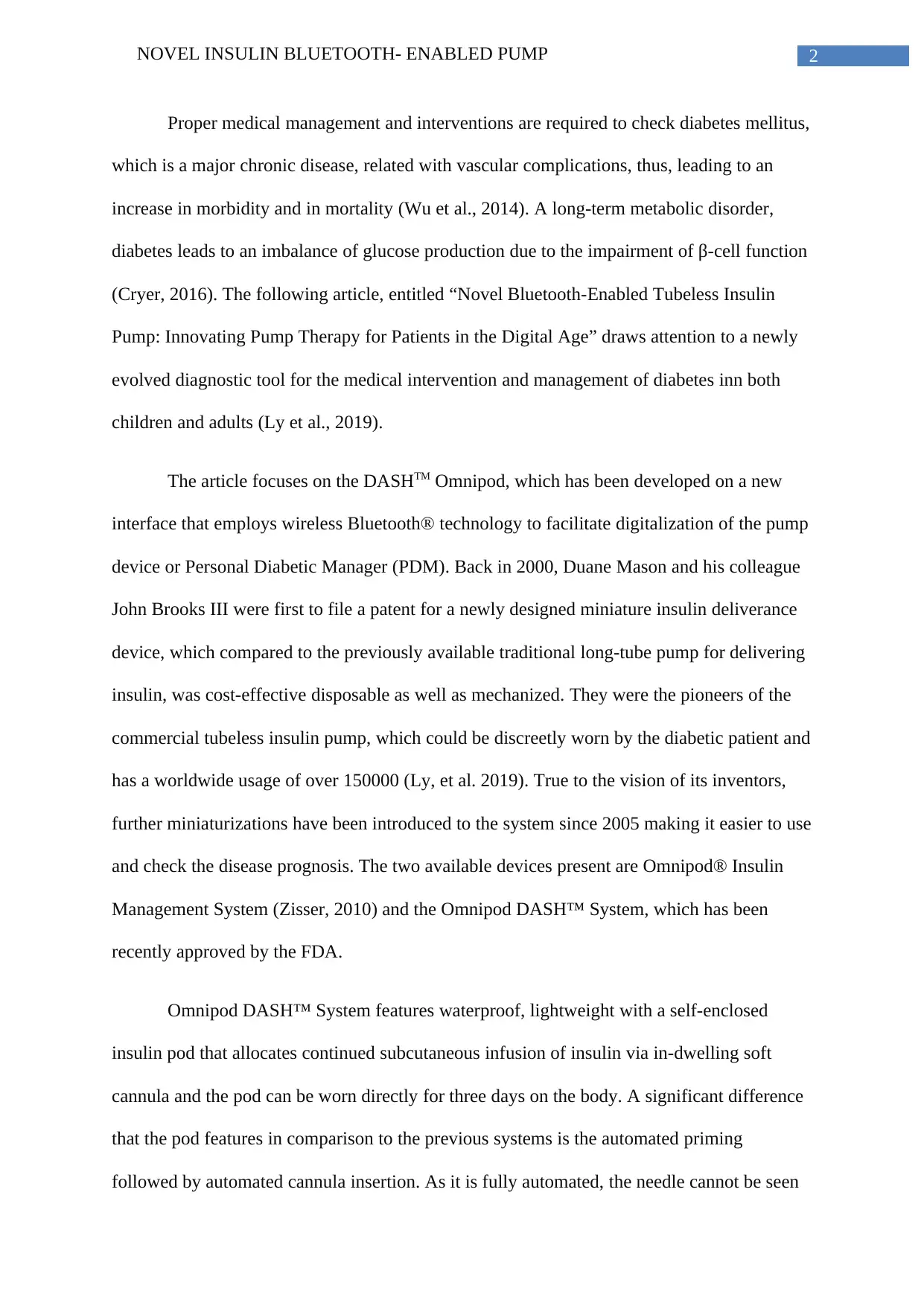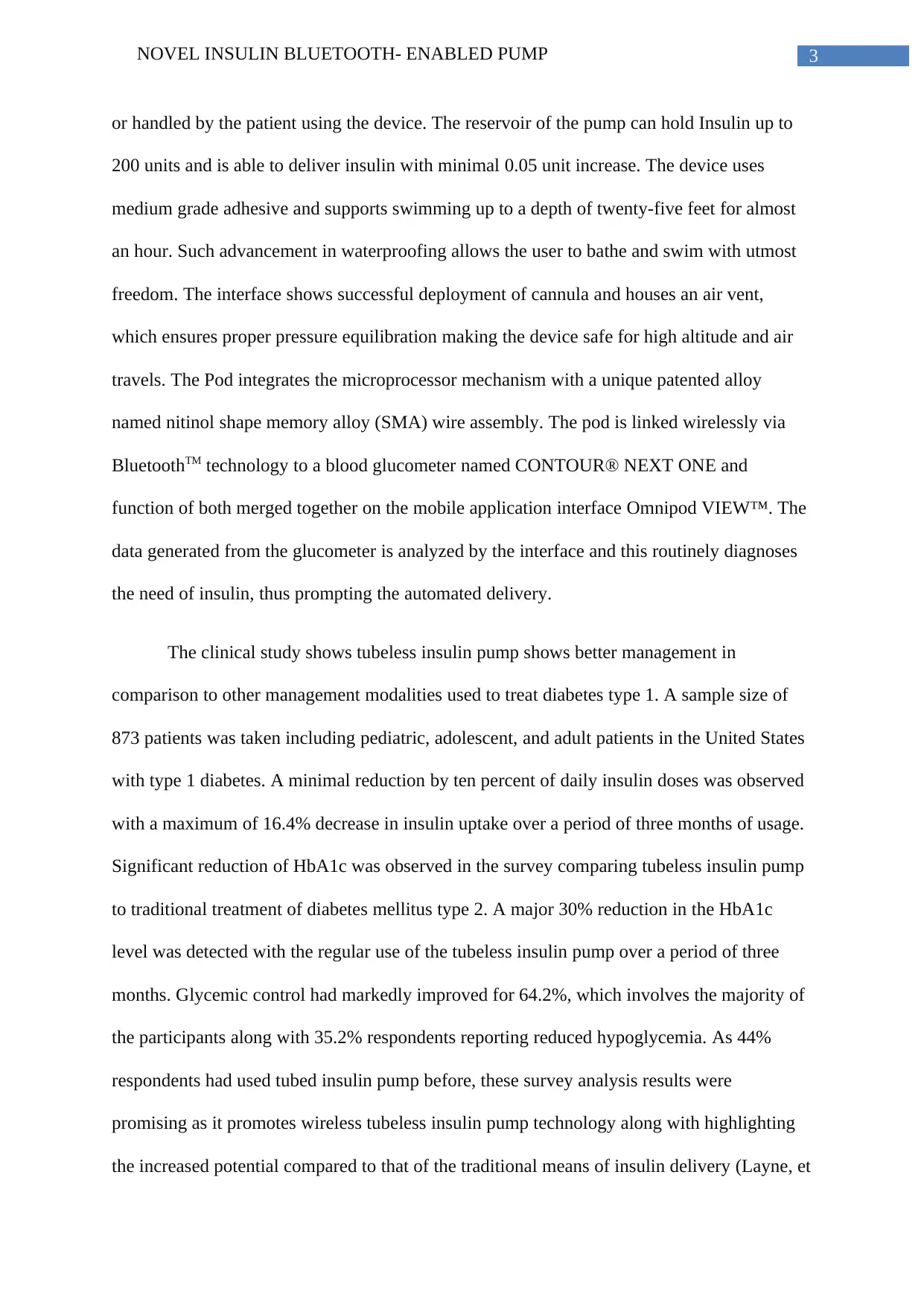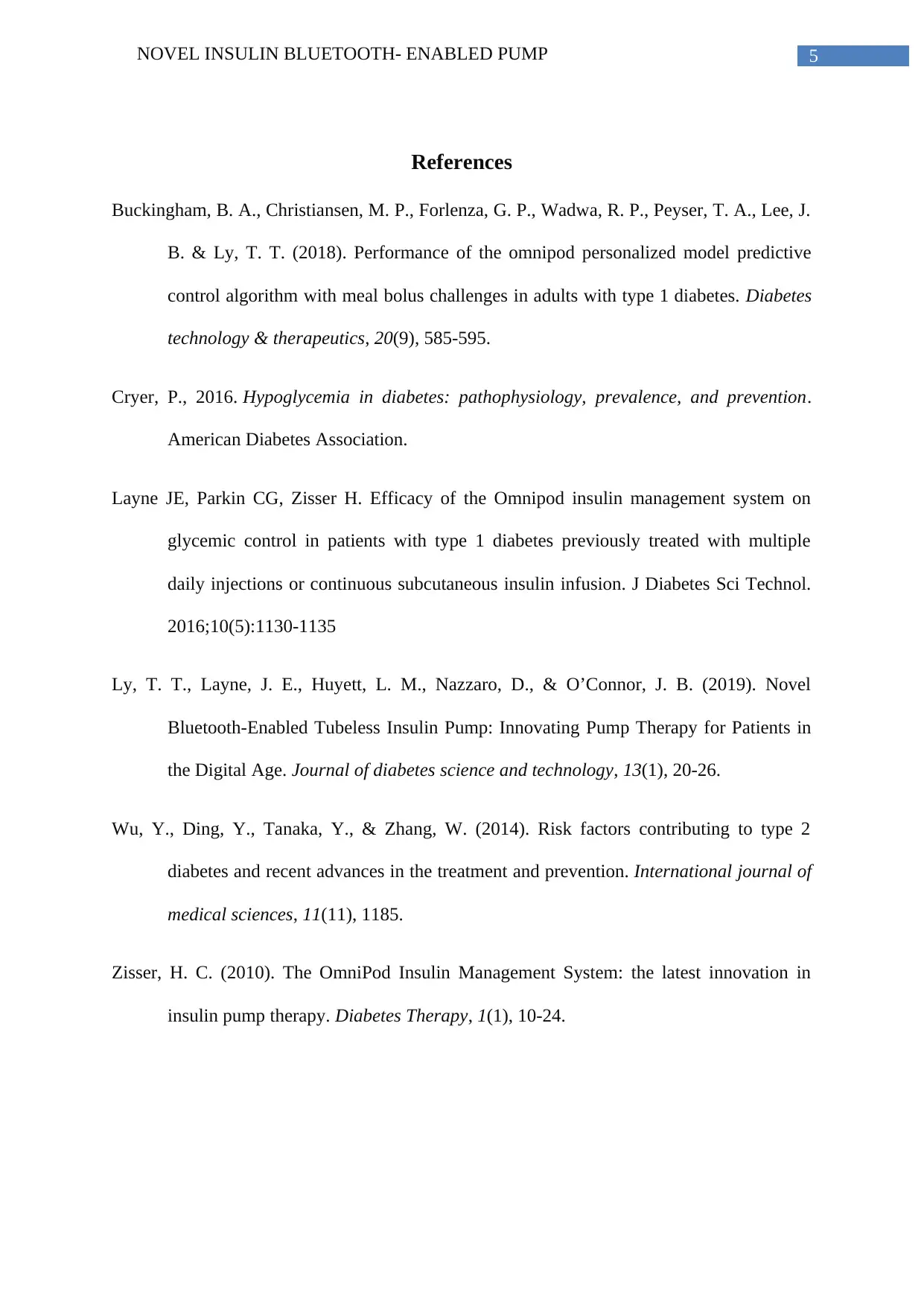Report: Novel Insulin Bluetooth-Enabled Pump Analysis
VerifiedAdded on 2023/01/10
|5
|1238
|31
Report
AI Summary
This report examines a novel Bluetooth-enabled tubeless insulin pump, specifically focusing on the Omnipod DASH™ system. It highlights the device's features, including its waterproof design, lightweight build, automated priming, and wireless connectivity via Bluetooth® technology. The report details how the pump integrates with a blood glucometer and mobile application for automated insulin delivery based on blood glucose readings. Clinical studies are cited, demonstrating improved glycemic control and reduced insulin doses in patients with type 1 diabetes using the tubeless pump compared to traditional methods. The report emphasizes the positive impact of this technology on patient engagement and care, and discusses the development of a futuristic model to predict insulin needs, thus, improving blood glucose level management.

1Running head: NOVEL INSULIN BLUETOOTH- ENABLED PUMP
NOVEL INSULIN BLUETOOTH- ENABLED PUMP
Name of the Student
Name of the University
Author’s Note
NOVEL INSULIN BLUETOOTH- ENABLED PUMP
Name of the Student
Name of the University
Author’s Note
Paraphrase This Document
Need a fresh take? Get an instant paraphrase of this document with our AI Paraphraser

2NOVEL INSULIN BLUETOOTH- ENABLED PUMP
Proper medical management and interventions are required to check diabetes mellitus,
which is a major chronic disease, related with vascular complications, thus, leading to an
increase in morbidity and in mortality (Wu et al., 2014). A long-term metabolic disorder,
diabetes leads to an imbalance of glucose production due to the impairment of β-cell function
(Cryer, 2016). The following article, entitled “Novel Bluetooth-Enabled Tubeless Insulin
Pump: Innovating Pump Therapy for Patients in the Digital Age” draws attention to a newly
evolved diagnostic tool for the medical intervention and management of diabetes inn both
children and adults (Ly et al., 2019).
The article focuses on the DASHTM Omnipod, which has been developed on a new
interface that employs wireless Bluetooth® technology to facilitate digitalization of the pump
device or Personal Diabetic Manager (PDM). Back in 2000, Duane Mason and his colleague
John Brooks III were first to file a patent for a newly designed miniature insulin deliverance
device, which compared to the previously available traditional long-tube pump for delivering
insulin, was cost-effective disposable as well as mechanized. They were the pioneers of the
commercial tubeless insulin pump, which could be discreetly worn by the diabetic patient and
has a worldwide usage of over 150000 (Ly, et al. 2019). True to the vision of its inventors,
further miniaturizations have been introduced to the system since 2005 making it easier to use
and check the disease prognosis. The two available devices present are Omnipod® Insulin
Management System (Zisser, 2010) and the Omnipod DASH™ System, which has been
recently approved by the FDA.
Omnipod DASH™ System features waterproof, lightweight with a self-enclosed
insulin pod that allocates continued subcutaneous infusion of insulin via in-dwelling soft
cannula and the pod can be worn directly for three days on the body. A significant difference
that the pod features in comparison to the previous systems is the automated priming
followed by automated cannula insertion. As it is fully automated, the needle cannot be seen
Proper medical management and interventions are required to check diabetes mellitus,
which is a major chronic disease, related with vascular complications, thus, leading to an
increase in morbidity and in mortality (Wu et al., 2014). A long-term metabolic disorder,
diabetes leads to an imbalance of glucose production due to the impairment of β-cell function
(Cryer, 2016). The following article, entitled “Novel Bluetooth-Enabled Tubeless Insulin
Pump: Innovating Pump Therapy for Patients in the Digital Age” draws attention to a newly
evolved diagnostic tool for the medical intervention and management of diabetes inn both
children and adults (Ly et al., 2019).
The article focuses on the DASHTM Omnipod, which has been developed on a new
interface that employs wireless Bluetooth® technology to facilitate digitalization of the pump
device or Personal Diabetic Manager (PDM). Back in 2000, Duane Mason and his colleague
John Brooks III were first to file a patent for a newly designed miniature insulin deliverance
device, which compared to the previously available traditional long-tube pump for delivering
insulin, was cost-effective disposable as well as mechanized. They were the pioneers of the
commercial tubeless insulin pump, which could be discreetly worn by the diabetic patient and
has a worldwide usage of over 150000 (Ly, et al. 2019). True to the vision of its inventors,
further miniaturizations have been introduced to the system since 2005 making it easier to use
and check the disease prognosis. The two available devices present are Omnipod® Insulin
Management System (Zisser, 2010) and the Omnipod DASH™ System, which has been
recently approved by the FDA.
Omnipod DASH™ System features waterproof, lightweight with a self-enclosed
insulin pod that allocates continued subcutaneous infusion of insulin via in-dwelling soft
cannula and the pod can be worn directly for three days on the body. A significant difference
that the pod features in comparison to the previous systems is the automated priming
followed by automated cannula insertion. As it is fully automated, the needle cannot be seen

3NOVEL INSULIN BLUETOOTH- ENABLED PUMP
or handled by the patient using the device. The reservoir of the pump can hold Insulin up to
200 units and is able to deliver insulin with minimal 0.05 unit increase. The device uses
medium grade adhesive and supports swimming up to a depth of twenty-five feet for almost
an hour. Such advancement in waterproofing allows the user to bathe and swim with utmost
freedom. The interface shows successful deployment of cannula and houses an air vent,
which ensures proper pressure equilibration making the device safe for high altitude and air
travels. The Pod integrates the microprocessor mechanism with a unique patented alloy
named nitinol shape memory alloy (SMA) wire assembly. The pod is linked wirelessly via
BluetoothTM technology to a blood glucometer named CONTOUR® NEXT ONE and
function of both merged together on the mobile application interface Omnipod VIEW™. The
data generated from the glucometer is analyzed by the interface and this routinely diagnoses
the need of insulin, thus prompting the automated delivery.
The clinical study shows tubeless insulin pump shows better management in
comparison to other management modalities used to treat diabetes type 1. A sample size of
873 patients was taken including pediatric, adolescent, and adult patients in the United States
with type 1 diabetes. A minimal reduction by ten percent of daily insulin doses was observed
with a maximum of 16.4% decrease in insulin uptake over a period of three months of usage.
Significant reduction of HbA1c was observed in the survey comparing tubeless insulin pump
to traditional treatment of diabetes mellitus type 2. A major 30% reduction in the HbA1c
level was detected with the regular use of the tubeless insulin pump over a period of three
months. Glycemic control had markedly improved for 64.2%, which involves the majority of
the participants along with 35.2% respondents reporting reduced hypoglycemia. As 44%
respondents had used tubed insulin pump before, these survey analysis results were
promising as it promotes wireless tubeless insulin pump technology along with highlighting
the increased potential compared to that of the traditional means of insulin delivery (Layne, et
or handled by the patient using the device. The reservoir of the pump can hold Insulin up to
200 units and is able to deliver insulin with minimal 0.05 unit increase. The device uses
medium grade adhesive and supports swimming up to a depth of twenty-five feet for almost
an hour. Such advancement in waterproofing allows the user to bathe and swim with utmost
freedom. The interface shows successful deployment of cannula and houses an air vent,
which ensures proper pressure equilibration making the device safe for high altitude and air
travels. The Pod integrates the microprocessor mechanism with a unique patented alloy
named nitinol shape memory alloy (SMA) wire assembly. The pod is linked wirelessly via
BluetoothTM technology to a blood glucometer named CONTOUR® NEXT ONE and
function of both merged together on the mobile application interface Omnipod VIEW™. The
data generated from the glucometer is analyzed by the interface and this routinely diagnoses
the need of insulin, thus prompting the automated delivery.
The clinical study shows tubeless insulin pump shows better management in
comparison to other management modalities used to treat diabetes type 1. A sample size of
873 patients was taken including pediatric, adolescent, and adult patients in the United States
with type 1 diabetes. A minimal reduction by ten percent of daily insulin doses was observed
with a maximum of 16.4% decrease in insulin uptake over a period of three months of usage.
Significant reduction of HbA1c was observed in the survey comparing tubeless insulin pump
to traditional treatment of diabetes mellitus type 2. A major 30% reduction in the HbA1c
level was detected with the regular use of the tubeless insulin pump over a period of three
months. Glycemic control had markedly improved for 64.2%, which involves the majority of
the participants along with 35.2% respondents reporting reduced hypoglycemia. As 44%
respondents had used tubed insulin pump before, these survey analysis results were
promising as it promotes wireless tubeless insulin pump technology along with highlighting
the increased potential compared to that of the traditional means of insulin delivery (Layne, et
⊘ This is a preview!⊘
Do you want full access?
Subscribe today to unlock all pages.

Trusted by 1+ million students worldwide

4NOVEL INSULIN BLUETOOTH- ENABLED PUMP
al. 2016). A futuristic model is being developed which will address an algorithm to predict
the need for insulin based on the previous readings, therefore keeping the blood glucose
levels from rising by automated monitored insulin delivery before the need (Buckingham et
al., 2018).
As diabetes is an incurable, chronic disease, its impact on the patient, emotionally and
physically, is of crucial concern in the diabetic community. Thus, the need for critical and
immediate technological upgrade facilitated with benefits such as reliability, discreetness,
waterproofing, wireless technology available in the newly patented Omnipod DASHTM device
analyzed in the article was highly welcomed. Carefully designed insulin management system,
The Omnipod DASHTM is extremely user friendly and provides extensive technological
advancements which leads to better engagement of the patient and the caregiver. A futuristic
model is already in the make, which will help in keeping the level of blood glucose from
rising before the requirement.
al. 2016). A futuristic model is being developed which will address an algorithm to predict
the need for insulin based on the previous readings, therefore keeping the blood glucose
levels from rising by automated monitored insulin delivery before the need (Buckingham et
al., 2018).
As diabetes is an incurable, chronic disease, its impact on the patient, emotionally and
physically, is of crucial concern in the diabetic community. Thus, the need for critical and
immediate technological upgrade facilitated with benefits such as reliability, discreetness,
waterproofing, wireless technology available in the newly patented Omnipod DASHTM device
analyzed in the article was highly welcomed. Carefully designed insulin management system,
The Omnipod DASHTM is extremely user friendly and provides extensive technological
advancements which leads to better engagement of the patient and the caregiver. A futuristic
model is already in the make, which will help in keeping the level of blood glucose from
rising before the requirement.
Paraphrase This Document
Need a fresh take? Get an instant paraphrase of this document with our AI Paraphraser

5NOVEL INSULIN BLUETOOTH- ENABLED PUMP
References
Buckingham, B. A., Christiansen, M. P., Forlenza, G. P., Wadwa, R. P., Peyser, T. A., Lee, J.
B. & Ly, T. T. (2018). Performance of the omnipod personalized model predictive
control algorithm with meal bolus challenges in adults with type 1 diabetes. Diabetes
technology & therapeutics, 20(9), 585-595.
Cryer, P., 2016. Hypoglycemia in diabetes: pathophysiology, prevalence, and prevention.
American Diabetes Association.
Layne JE, Parkin CG, Zisser H. Efficacy of the Omnipod insulin management system on
glycemic control in patients with type 1 diabetes previously treated with multiple
daily injections or continuous subcutaneous insulin infusion. J Diabetes Sci Technol.
2016;10(5):1130-1135
Ly, T. T., Layne, J. E., Huyett, L. M., Nazzaro, D., & O’Connor, J. B. (2019). Novel
Bluetooth-Enabled Tubeless Insulin Pump: Innovating Pump Therapy for Patients in
the Digital Age. Journal of diabetes science and technology, 13(1), 20-26.
Wu, Y., Ding, Y., Tanaka, Y., & Zhang, W. (2014). Risk factors contributing to type 2
diabetes and recent advances in the treatment and prevention. International journal of
medical sciences, 11(11), 1185.
Zisser, H. C. (2010). The OmniPod Insulin Management System: the latest innovation in
insulin pump therapy. Diabetes Therapy, 1(1), 10-24.
References
Buckingham, B. A., Christiansen, M. P., Forlenza, G. P., Wadwa, R. P., Peyser, T. A., Lee, J.
B. & Ly, T. T. (2018). Performance of the omnipod personalized model predictive
control algorithm with meal bolus challenges in adults with type 1 diabetes. Diabetes
technology & therapeutics, 20(9), 585-595.
Cryer, P., 2016. Hypoglycemia in diabetes: pathophysiology, prevalence, and prevention.
American Diabetes Association.
Layne JE, Parkin CG, Zisser H. Efficacy of the Omnipod insulin management system on
glycemic control in patients with type 1 diabetes previously treated with multiple
daily injections or continuous subcutaneous insulin infusion. J Diabetes Sci Technol.
2016;10(5):1130-1135
Ly, T. T., Layne, J. E., Huyett, L. M., Nazzaro, D., & O’Connor, J. B. (2019). Novel
Bluetooth-Enabled Tubeless Insulin Pump: Innovating Pump Therapy for Patients in
the Digital Age. Journal of diabetes science and technology, 13(1), 20-26.
Wu, Y., Ding, Y., Tanaka, Y., & Zhang, W. (2014). Risk factors contributing to type 2
diabetes and recent advances in the treatment and prevention. International journal of
medical sciences, 11(11), 1185.
Zisser, H. C. (2010). The OmniPod Insulin Management System: the latest innovation in
insulin pump therapy. Diabetes Therapy, 1(1), 10-24.
1 out of 5
Your All-in-One AI-Powered Toolkit for Academic Success.
+13062052269
info@desklib.com
Available 24*7 on WhatsApp / Email
![[object Object]](/_next/static/media/star-bottom.7253800d.svg)
Unlock your academic potential
Copyright © 2020–2025 A2Z Services. All Rights Reserved. Developed and managed by ZUCOL.